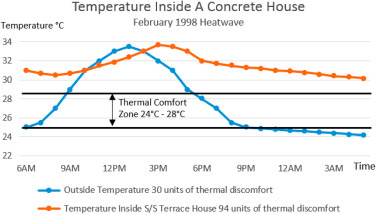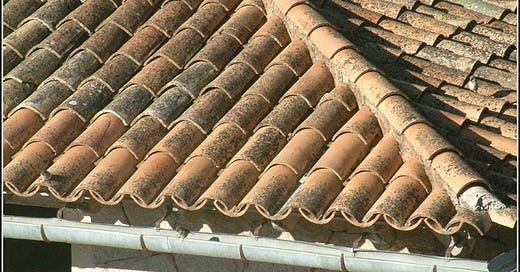During my school days, we lived in a house, whose walls were made of soil. It was a kind of cob house. I was told that the age of the house was 200 years. Well! That could have been an exaggeration. But the age of the house could not be anything less than 100 years. Because the house did not have a title deed when our family purchased it. It was built before the British passed their first property registration law in India.
The walls would have bulges and looked asymmetric in some places. Every year, during a regional festival called Pongal, every house in town would get a lime wash. For us, the whitewash would take a week to cover the house. In places of the walls where the lime plaster had fallen from, the grainy red soil would be visible. I did not quite like those walls when compared to the walls of the modern houses of the period.
During the 80s in India, modern houses started to emerge with well-defined shapes, perfect right-angled corners, smooth wall surfaces, and flat roofs. When I first visited a house with a flat concrete roof and mosaic tiled floor, I found our own house lacking some desirable aesthetics. The mosaic tiles made the floors more beautiful with interesting patterns. The flat roofs of the houses were the centre of my admiration. I loved them for their flatness, smoothness whereas our house had a sloping roof with clay tiles. The walls were protected by the roof overhang. They were a kind of monk and nun tiles that required regular maintenance.

The major problem with our roof was cobweb and dust. We had to clean the cobweb periodically. Considering the intricate structure of clay tiles and the height of the roof, having a thorough cleaning would be a tough job. We had no vacuum cleaners those days. The only interesting thing that happened to me as a boy was that I could watch spiders building their web right from scratch, setting up the trap, and hunting insects.
Different places of the roof would have different cobweb belonged to different spider species. They required different cleaning tactics too. Besides a few classical spider web, our house had a lot of web sheets that looked like the one in the picture. Just imagine having this above your head.
I was learning photography from my father and we even had a darkroom for ‘developing’ films and to ‘print’ black and white photographs. We have printed hundreds of photographs in the house with mud walls and a roof with cobweb. The house served every purpose, except for the fact that I did not find it modern and trendy. I remember myself being disgruntled with my father as he did not have an idea of rebuilding the house in a modern way.
Later in my life, after graduating I moved to Bangalore. From that point, I have lived in a few concrete buildings of different types. I loved most of them for different reasons. But something was missing. I found that all the concrete buildings I lived in were hot in summer. When I learnt the reason, I realized that the houses were not only hot but hotter than outside.
A typical concrete building gives thermal discomfort inside the building even after the sunset. Check the following chart.

The blue line represents temperature outside and the red line represents temperature inside a concrete house. From the graph one can see after 6 PM, the temperature inside the house is multiple times higher than the temperature outside the house. I found that ridiculous. Don’t you?
The research says
‘increase of indoor temperature compared with outdoor temperature is a major concern in modern house design. Occupants suffer from this uncomfortable condition because of overheating indoor temperature. ….’ ‘During daytime, the roof accumulates heat, which increases the indoor temperature and affects the comfort level of the occupants. To maintain the indoor temperature within the comfort level, most house designs usually depend on mechanical means by using fans or air conditioning systems. The dependence on a mechanical ventilation system could lead to additional costs for its installation, operation, and maintenance.’A literature review on the improvement strategies of passive design for the roofing system of the modern house in a hot and humid climate region.
Roslan, Qairuniza & Siti Halipah, Ibrahim & Affandi, Rohaida & Mohd Nawi, Mohd Nasrun & Baharun, Azhaili. (2015)
Frontiers of Architectural Research. 5. 10.1016/j.foar.2015.10.002
Modern concrete houses turn very hot during summer, and very cold during winter. During the summer, the temperature inside the house is more than the temperature outside. For me, it looked like an oven in places like Chennai in summer. We spend more energy on air-conditioners to keep the inside temperature comfortable.
Running an air-conditioner round the clock can cause health problems. It is unhygienic. More use of air-conditioner has the following disadvantages.
Can affect the respiratory system if an individual is vulnerable
Can transmit infectious respiratory diseases (This is why during the unlocking phase of COVID19 lockdown, air conditioners were not allowed in public buildings in India)
Airborne dust & fungi can cause an allergic reaction
Sometimes indoor air pollution is greater than outdoor air pollution. The air conditioner makes the situation worse in such a case.
This is list is partial. Designing a passive solar house (we will talk more about this later), keeping more plants, having good ventilation and all could help the heating of concrete buildings. But building with concrete and running air-conditioner as the fix is not a wise thing to do, in my opinion.
The modern building approaches adapted in India if not worldwide, don't take thermal comfort and indoor air quality as prime objectives. That is what the following research talks about.
'Another important factor to consider during the construction of a building is the thermal comfort of the indoor-space. However, in the past few decades, the thermal performance of the building is not considered during the design and construction phase. This results in buildings with a poor thermal performance. After the building is constructed, the indoor thermal comfort is achieved using mechanical air-conditioning systems that are not only energy intensive but also eco-destructive. This was not the case before the advent of the modern air-conditioning systems. Thermal comfort was achieved by designing the building to suit the local climatic conditions.' Original Article/Research
Thermal comfort in traditional buildings composed of local and modern construction materials
D.G. Leo Samuela, K. Dharmasasthaa, S.M. Shiva Nagendrab, M. Prakash Maiyaaa
Department of Mechanical Engineering, Indian Institute of Technology Madras, Chennai 600036, India Department of Civil Engineering, Indian Institute of Technology Madras, Chennai 600036, India
In light of all this information, my fascination with concrete buildings and flat roofs was smashed. Instead of building a ‘modern house’, I decided to build a house that is not hotter than the summer itself. And I did not forget the fact that our old mud house did not give us any discomfort during the summer and the winter.
So, I started looking for a modern mud building idea. But I did not know my quest for the right building material was going to be an exploration of a vast territory.
Like to get the posts delivered to your inbox?
Think someone would like this post?



